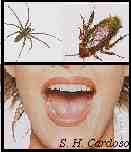| Introduction

|
Fear
is a very ancient and universal emotion in man. It can be defined as the
sensation that you are in danger, that something bad is about to happen.
Fear is almost always accompanied by a host of physical symptoms which
are quite disturbing. When it is not justified by the presence of real
danger or threat, or by any rational cause, and when it is also accompanied
by a systematic avoidance of the situations which lead to it, then we have
what is called a phobia.
Phobia is actually a kind of panic reaction caused by specific stimuli
or situations. There are three basic types of phobia:
-
Agarophobia, literally, it is the irrational fear of the agora
(in ancient Greece, this was the place where the market was located), in
other words, the generalized fear of places or situations where there is
a potential difficulty or embarassment to escape from it, or where help
might not be available in case of need. This includes going out of our
own's home, travelling without company, or being in the middle of a crowd,
standing in queues to leave a place, etc.
-
Social phobia, when the person has a marked and persistent fear
of some specific or generalized social situations, such as the shame of
misbehaving in front of other people, the fear of participating in group
reunions, of starting or maintaining a conversation with strangers, of
initiating a romantic encounter, of talking to persons of authority, etc.
-
Specific phobias, when there is a marked and persistent fear in
the presence, or even by anticipation of encountering specific objects
and situations, such as the fear of flying, injections, coackroaches, dogs,
of seeing blood, high places, taking a lift, driving an automobile, or
staying in enclosed and restrictive places, such as tunnels or traffic
jams.
|
Origins
 |
Six
of every ten persons who suffer phobias are able to remember when the fear
crisis occurred for the first time, i.e., when the sensation of panic became
attached to the place or situation where it first happened.
For these persons, there is a very clear connection between the object
and the sensation of fear. For example, a man, by some unexplained reason,
suffers for the first time a strong attack of anxiety or panic when he
is driving his automobile. From this day on, he avoids driving alone, out
of fear that he will be subjected to the same sensation and will lose control,
without anyone near him to help him out. Then, this fear may expand to
and cover other situations where he might feel ill and the escape from
it is difficult, such as in a movie theather. In this manner, agarophobia
arises , the generalized fear of "getting ill" and be unable to escape
from it or get help.
In another example, a woman had a traumatic experience in a car crash.
From this day on, she is panick-stricken everytime she is required to board
a vehicle and develops a specific phobia to cars. Please note that agarophobia
(the previous example) and car phobia are fundamentally the same, but their
origin, and even the kind of fear, are different from one another. In the
first case, what the patient is avoiding is any situation where help might
be difficult or complicated, while in the second case, what the patient
is avoiding is the object in itself, i.e., the car.
But why a person becomes afflicted with phobia ? And why some phobias
are more common than others ?
Many neuroscientists believe that there is a clear involvement of biological
factors. For example, functional brain imaging studies have shown that
there is an increased blood flow and cell metabolic actiity on the right
side of the brain in phobic patients. It has also been demonstrated that
identical twins may develop the same type of phobia, even when they were
reared separately soon after birth, and educated in different places.
It may be also true that human beings are biologically prone to acquire
fear of certain noxious animals or situations, sich as rats, poisonous
animals, animals with a disgusting appearance, such as frogs, slugs or
cockroaches, etc. In a classical experiment, the American psychologist
Marting Seligman associated an aversive stimulation (a small electric shock)
to certain pictures. Two to four shocks were enough to establish a phobia
to pictures of spiders or snakes, while a much larger series of shocks
was needed to cause phobia to pictures of flowers, for example.
One possible explanation is that those fears where originally important
for the survival of the human species thousands of years ago and that they
lie dormant inside our brains, just waiting to be awaken at any time.
Another reason for the development of phobias is that we often associate
danger to things and situations that we cannot prevent or control, such
as lightning strikes during a storm, or the attack of a dangerous animal.
In this sense, patients who have a clinically-established panic disorder,
often end developing phobia to their own crisis, because they feel totally
helpless in controlling it. In consequence, they start avoiding going to
or staying in places or situation where they might become publicly embarassed
or unable to escape, due to the onset of the crisis.
Finally, there is also the social component or cultural influences on
phobia. For example, there is a kind of phobia called taijin kyofusho,
which occurs only in Japan. In contrast to what happens in the social phobias
(when the patient is afraid of being hummiliated or loathed by other persons),
taijin kyofusho is the fear of offending other persons by an excess of
modesty or showing respect ! The patient is afraid that his social behavior
or an imaginary physical defect might offend or embarass other people.
As you can see, this kind of fear occurs very rarely in a Western society...
What is a common feature of all phobias, then, is that the brain establishes
powerful and enduring new connections in situations of great emotion.
In order to understand better what goes on inside our brain when these
connections are formed, you could think a little about an universal situation.
You probably remember a situation in the past , when you was enjoying the
company of another person, in a very pleasant atmosphere, with a nice musical
background. Now, every time the same melody is played, you recall the situation.
Perhaps even the same pleasant sensations will be felt again.
This was a positive feeling, but in our brain the phenomenon occurs
exacty in the same way for fear sensations. In general, any strong emotion
bcomes easily attached to the surrounding events or environment. Usually,
phobias develop as the consequence of feelings of anxiety or panic being
elicited in potentially dangerous situations.
No animal likes to be cornered or trapped in a place or near another
animal where it cannot escape from in case of danger. And we are animals
too, remember ?
To be trapped in a traffic jam, inside a lift cabin or in a shopping
mall full of people evokes a similar sensation of being cornered, with
no way out, for people who suffer phobias. This is the simple reason why
so many patients with clinical panic disorder develop a phobia to enclosed
spaces (claustrophobia). |

